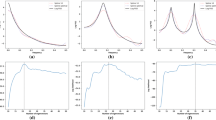Abstract
Heteroskedasticity and autocorrelation consistent (HAC) covariance matrix estimation, or HAC estimation in short, is one of the most important techniques in time series analysis and forecasting. It serves as a powerful analytical tool for hypothesis testing and model verification. However, HAC estimation for long and high-dimensional time series is computationally expensive. This paper describes a pipeline-friendly HAC estimation algorithm derived from a mathematical specification, by applying transformations to eliminate conditionals, to parallelise arithmetic, and to promote data reuse in computation. We discuss an initial hardware architecture for the proposed algorithm, and propose two optimised architectures to improve the worst-case performance. Experimental systems based on proposed architectures demonstrate high performance especially for long time series. One experimental system achieves up to 12 times speedup over an optimised software system on 12 CPU cores.






Similar content being viewed by others
References
Jegadeesh, N., & Titman, S. (1993). Returns to buying winners and selling losers: implications for stock market efficiency. The Journal of Finance, 48(1), 65–91.
Bollerslev, T., Tauchen, G., Zhou, H. (2009). Expected stock returns and variance risk premia. Review of Financial Studies, 22(11), 4463–4492.
Bekaert, G., Harvey, C., Lundblad, C., Siegel, S. (2011). What segments equity markets.Review of Financial Studies, 24(12), 3841–3890.
Guo, C., & Luk, W. (2013). Accelerating HAC estimation for multivariate time series. International conference on application-specific systems. Architectures and Processors.
Hamilton, J. D. (1994). Time series analysis. Cambridge University Press.
Newey, W. K., & West, K. D. (1987). A simple, positive semi-definite, heteroskedasticity and autocorrelation consistent covariance matrix. Econometrica: Journal of the Econometric Society, 55, 703–708.
Newey, W. K., & West, K. D. (1994). Automatic lag selection in covariance matrix estimation. Review of Economic Studies, 61, 631–653.
Andrews, D. (1991). Heteroskedasticity and autocorrelation consistent covariance matrix estimation. Econometrica: Journal of the Econometric Society, 59, 817–858.
Sart, D., Mueen, A., Najjar, W., Keogh, E., Niennattrakul, V. (2010). Accelerating dynamic time warping subsequence search with GPUs and FPGAs. International conference on data mining (pp. 1001–1006).
Wang, Z., Huang, S., Wang, L., Li, H., Wang, Y., Yang, H. (2013). Accelerating subsequence similarity search based on dynamic time warping distance with FPGA. International symposium on field-programmable gate arrays.
Preis, T., Virnau, P., Paul, W., Schneider, J. J. (2009). Accelerated fluctuation analysis by graphic cards and complex pattern formation in financial markets. New Journal of Physics, 11(9), 093024.
Gembris, D., Neeb, M., Gipp, M., Kugel, A., Männer, R. (2011). Correlation analysis on GPU systems using NVIDIA’s CUDA. Journal of Real-Time Image Processing, 6(4), 275–280.
Baker, Z., & Prasanna, V. (2005). Efficient hardware data mining with the apriori algorithm on FPGAs. International symposium on field-programmable custom computing machines (pp. 3–12).
Agrawal, R., & Srikant, R. (1994). Fast algorithms for mining association rules. International conference on very large databases (VLDB) (pp. 487–499).
MacQueen, J. (1967). Some methods for classification and analysis of multivariate observations. Berkeley symposium on mathematical statistics and probability (pp. 281–297).
Quinlan, J. R. (Mar. 1986). Induction of decision trees. Machine Learning, 1(1), 81–106.
Saegusa, T., & Maruyama, T. (2006). An FPGA implementation of K-means clustering for color images based on kd-tree. International conference on field programmable logic and applications (pp. 1–6).
Narayanan, R., Honbo, D., Memik, G., Choudhary, A., Zambreno, J. (2007). An FPGA implementation of decision tree classification. Conference on design, automation and test in Europe (pp. 1–6).
Moerland, P., & Fiesler, E. (1997). Neural network adaptations to hardware implementations. Tech. Rep., Switzerland: The Idiap Research Institute.
Guo, C., Fu, H., Luk, W. (2012). A fully-pipelined expectation-maximization engine for Gaussian mixture models. International conference on field-programmable technology.
Zeileis, A. (2004). Econometric computing with HC and HAC covariance matrix estimators.Distributed with the sandwich R package.
Cottrell, A., & Lucchetti, R. (2012). Gretl user’s guide.Distributed with the Gretl library.
Lin, C. Y., So, H. K., Leong, P. H. W. (2011). A model for matrix multiplication performance on FPGAs. International conference on field programmable logic and applications (pp. 305–310).
Jacob, A. C., Buhler, J. D., Chamberlain, R. D. (2010). Rapid RNA folding: analysis and acceleration of the zuker recurrence. International symposium on field-programmable custom computing machines (pp. 87–94).
Urquhart, R., & Wood, D. (1984). Systolic matrix and vector multiplication methods for signal processing. IEE Proceedings, 131(6), 623–631.
Acknowledgments
The authors would like to thank the anonymous reviewers for their constructive comments. This work is supported in part by the China Scholarship Council, by the European Union Seventh Framework Programme under grant agreement number 257906, 287804 and 318521, by UK EPSRC, by Maxeler University Programme, and by Xilinx.
Author information
Authors and Affiliations
Corresponding author
Rights and permissions
About this article
Cite this article
Guo, C., Luk, W. Pipelined HAC Estimation Engines for Multivariate Time Series. J Sign Process Syst 77, 117–129 (2014). https://doi.org/10.1007/s11265-014-0897-9
Received:
Revised:
Accepted:
Published:
Issue Date:
DOI: https://doi.org/10.1007/s11265-014-0897-9




